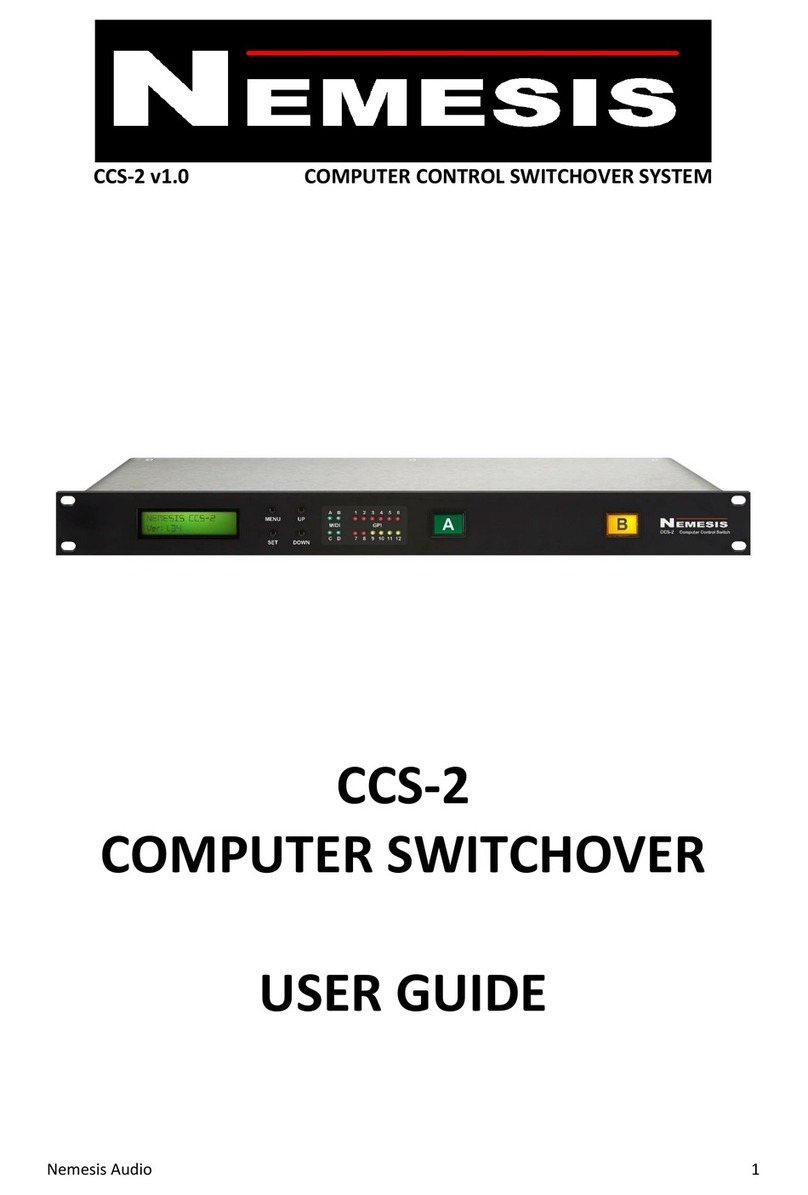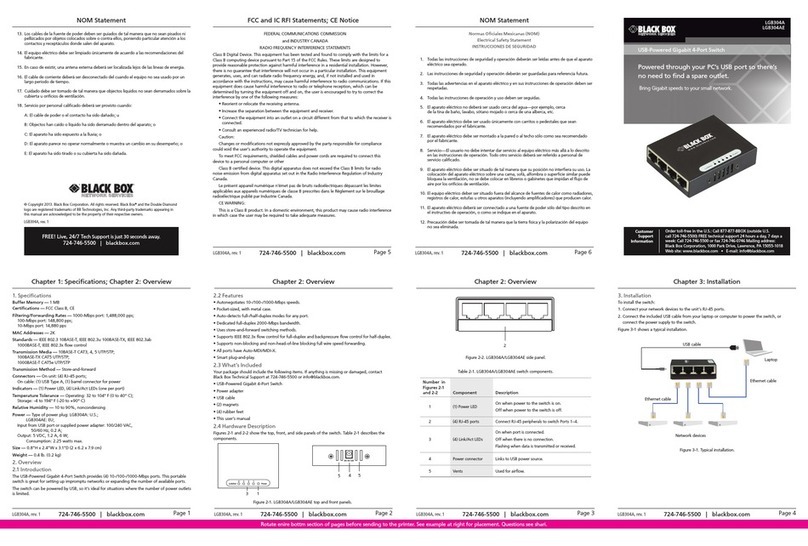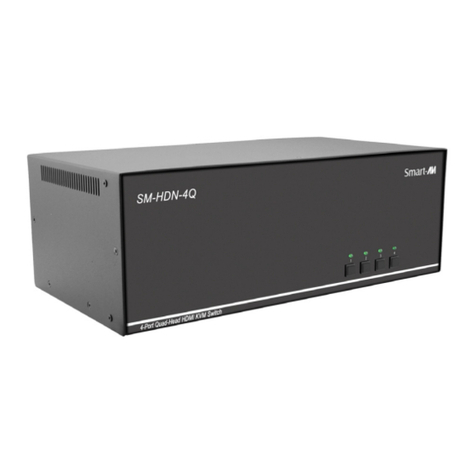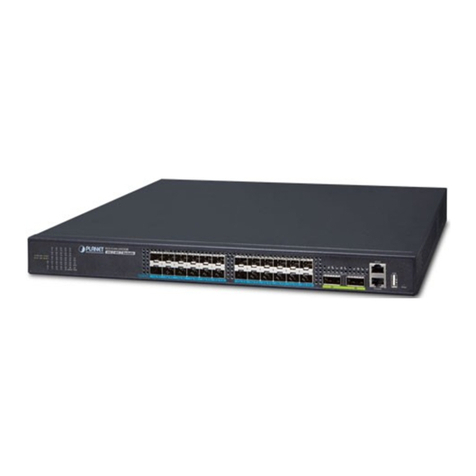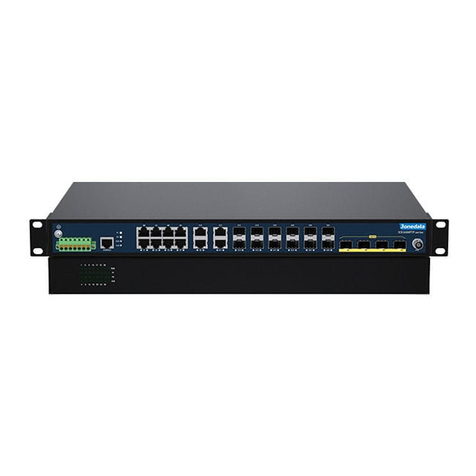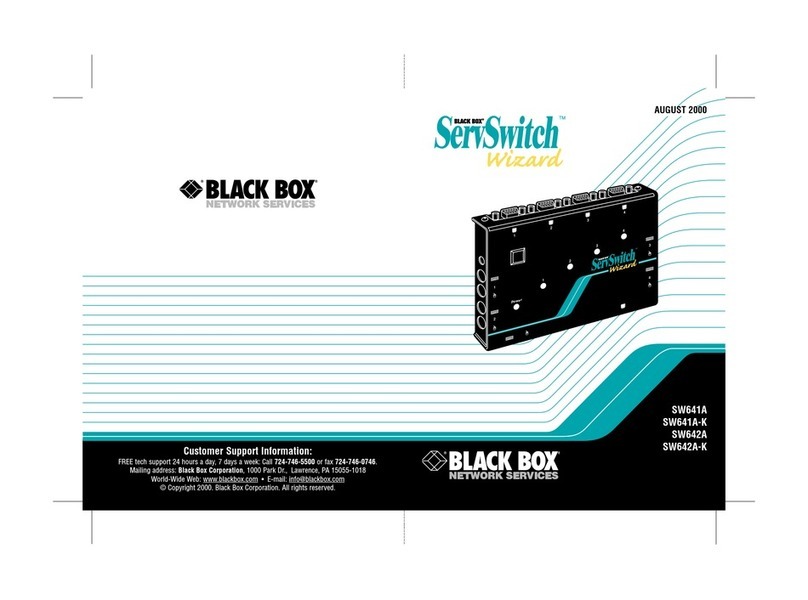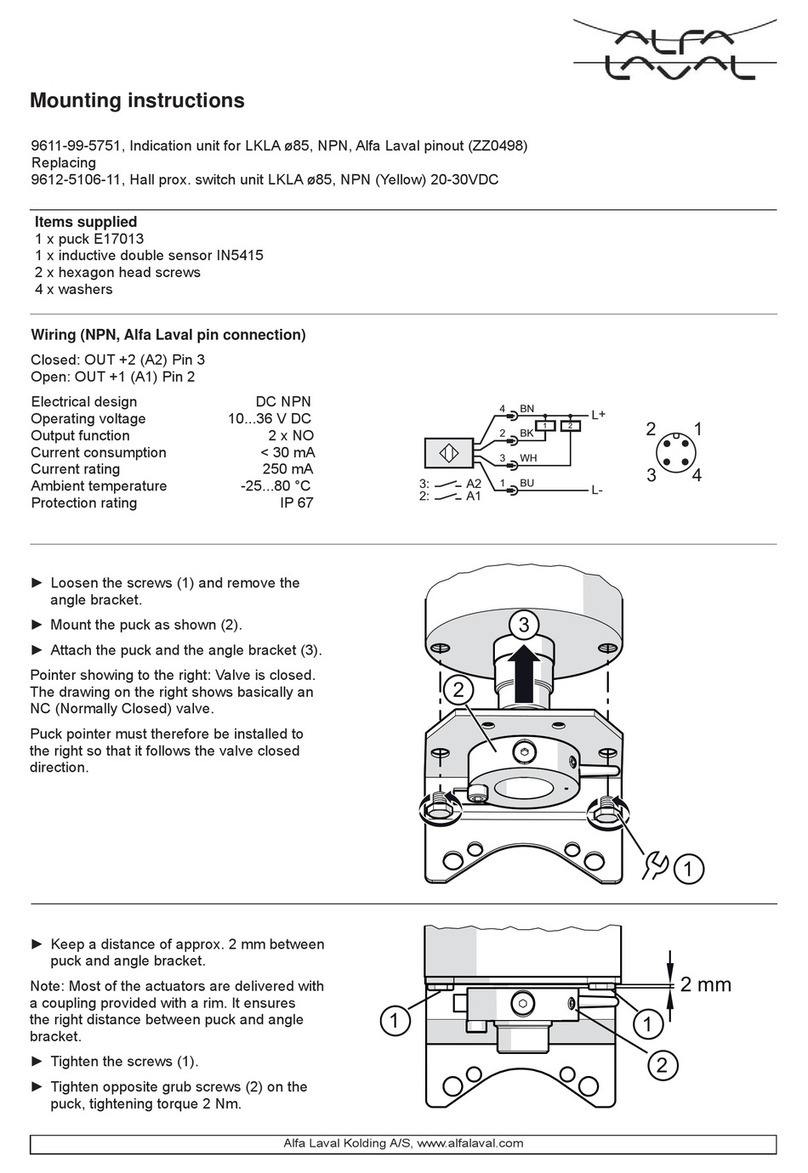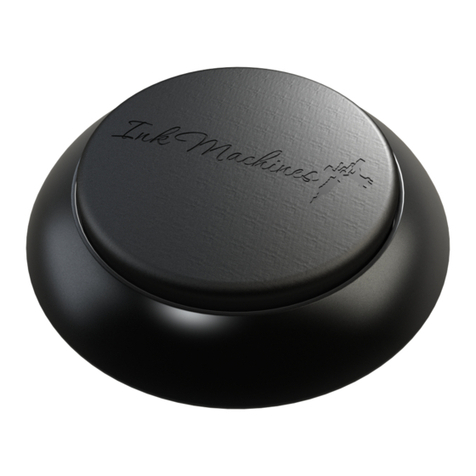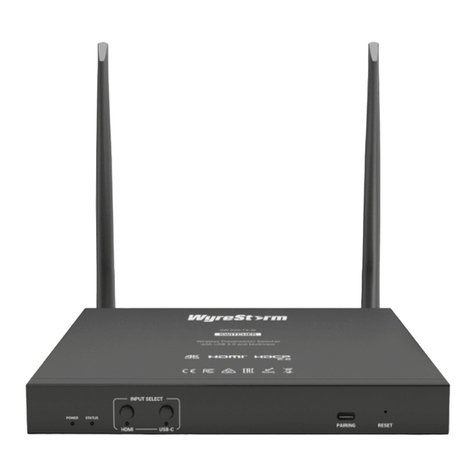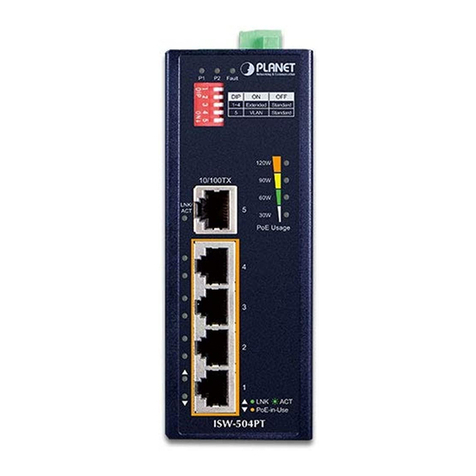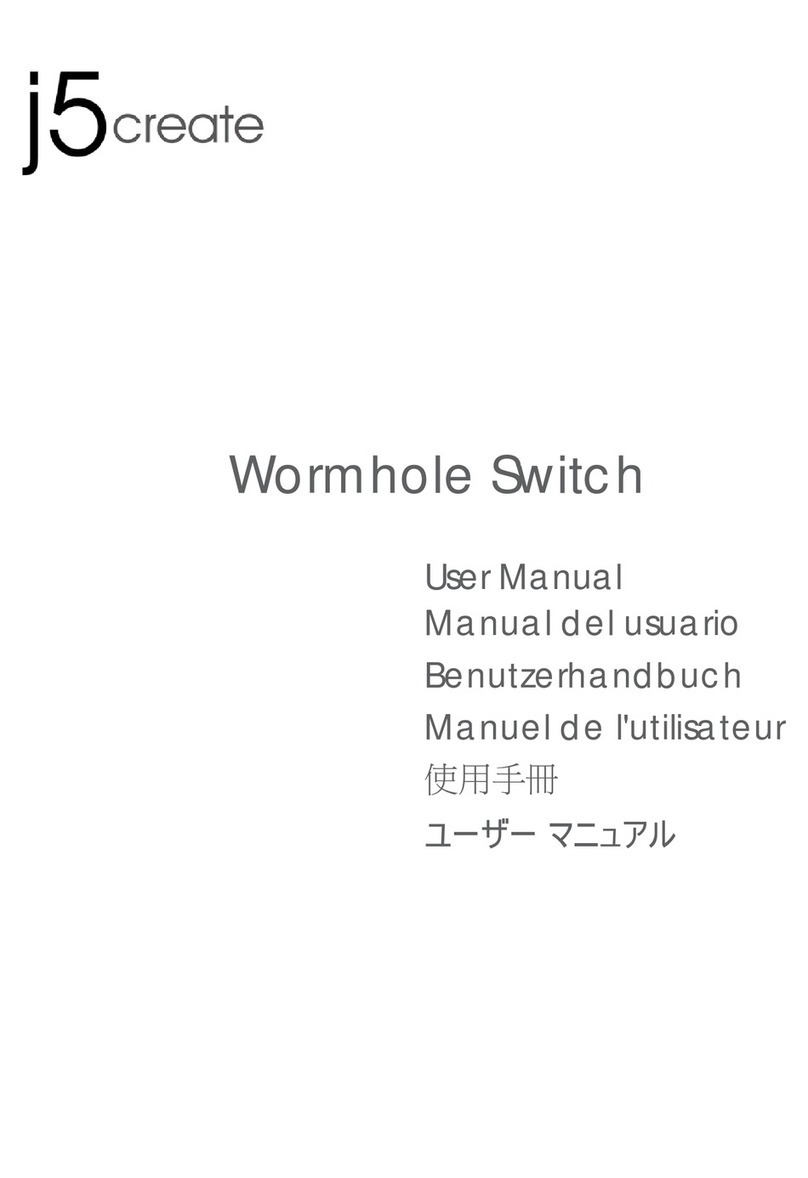Nemesis MADISW User manual

Nemesis Audio 1
MADISW v1.1 MADI DIGITAL AUDIO SWITCHOVER
MADISW
DIGITAL AUDIO SWITCHOVER
USER GUIDE

Nemesis Audio 2
Overview
The Nemesis MADISW is a 64-channel MADI compliant digital audio switchover device.
Primarily designed to switch between a main and backup MADI source, the MADISW can also be
used as a distribution amplifier and format converter.
Dual, wide-ranging power supplies and auto-switching input stages help to increase reliability in
critical situations.
The MADISW also has an integrated Word Clock distribution circuit to simplify system connection.
All MADI signals are delivered in their original format, meaning that additional control-over-MADI
data (such as desk control) is unaffected by the unit’s processing.
Auto-sensing channel input circuitry can help to increase reliability by utilising redundant input
connections in the case of cable or output driver failure.
During normal operation, to switch from source A to source B, press the large front panel buttons to
switch to the desired source. This can also be controlled via buttons in a remote box.
The MADISW will always boot to source A.
Diagram of Internal Operation

Nemesis Audio 3
Front Panel
Power Supply
The MADISW has 2 internal switched mode power supplies wired together in a redundant
configuration. During normal use, both supplies will provide power to the unit, although should a
fault develop, one supply is capable of powering the unit.
PSU 1 –Shows the status of Power Supply 1.
PSU 2 –Shows the status of Power Supply 2.
Should either of the LEDs illuminate red, the unit should be sent back to the factory for repair.
Clock Status
Shows information about the status of the word clock distributor circuit.
Unlock –The Word Clock input is unconnected, the signal level too low, or the clock signal is outside
of the detection range of the unit (44.1kHz-96kHz). The MADISW is internally terminated so if
parallel connections are being made ensure there is no other termination on the signal path.
Lock –The Word Clock input is valid and within the accepted ranges.
GREEN –Signal present at 44.1/48kHz.
YELLOW –Signal present at 88.2/96kHz.
Please note that the MADISW is a switcher and not a processor, so the clock signal found in the
distributor circuit is not multiplexed into the outgoing MADI signal, nor will the unit strip clock from
any incoming MADI signal. This indication is for the word clock sub-circuit only and not an indication
of MADI sync. There is no requirement to use this word clock distributor if an alternative system is
available, although the switching core will attempt to switch on a clock edge if the signal is available.
See “Technical Info” for more information.
Channel Source
The channel A and B input source for the MADISW can be either electrical or optical format. If an
optical signal is detected, the unit will automatically switch to this input, otherwise the coaxial BNC
input is selected.
BNC –The MADISW channel input source is currently the BNC coaxial socket. Illuminates red if no
signal is detected at the connector, otherwise illuminates green.
OPTICAL –The MADISW channel input source is current the SC Fibre connection.
Output Mode
Indicates the current routing strategy for the configurable sections of signal flow.
See “Modes of Operation” for further details on this and the LED indication.

Nemesis Audio 4
Connections
AC MAINS –Powercon™connector to connect to the Mains supply. Dual Internal Power Supplies are
capable of running on 100-240VAC 50/60Hz.
AUX 1 –Auxiliary 1 BNC MADI Output Connector. By default, a copy of the switched signal is present
on this connector, although this mode can be changed. See “Modes of Operation”.
AUX 2- Auxiliary 2 BNC MADI Output Connector. By default, a copy of the switched signal is present
on this connector, although this mode can be changed. See “Modes of Operation”.
AUX IN –75 Ohm BNC Connector. Auxiliary MADI Input for distribution to AUX Outputs.
Channel A:
Optical IN/OUT –SC Fibre Connector. Channel A MADI inputs and outputs. This connector takes
priority over the BNC input when an input is present at both connectors of the same channel. See
“Modes of Operation” for signal routing information.
Coax IN/OUT –75 Ohm BNC Connector. Channel A MADI inputs and outputs. This connector will be
active only when no signal is present at the optical connection. See “Mode of Operation” for signal
routing information.
Channel B:
Optical IN/OUT –SC Fibre Connector. Channel B MADI inputs and outputs. This connector takes
priority over the BNC input when an input is present at both connectors of the same channel. See
“Modes of Operation” for signal routing information.
Coax IN/OUT –75 Ohm BNC Connector. Channel B MADI inputs and outputs. This connector will be
active only when no signal is present at the optical connection. See “Mode of Operation” for signal
routing information.
WORDCLOCK IN –75 Ohm BNC Connector. Input connection for the built in word clock distribution
amplifier. If connected, the routing core will also switch the MADI signal on a clock edge, in most
cases resulting in a cleaner and quieter switchover. See “Technical Info” for more information on the
methods of MADI switching used. Internally terminated to 75 ohms.
WORDCLOCK OUT 1 –A buffered copy of the word clock signal for connecting to source equipment.
WORDCLOCK OUT 2 –A buffered copy of the word clock signal for connecting to source equipment.
REMOTE –5 Pin Female XLR Connector. Connection point for a remote control box following the
standard Nemesis remote control protocol. Allows connection of 2 buttons (“A” and “B”) and 2
indicator lamps (“Lamp A” and “Lamp B”). See “Technical Specifications” for connection pinout.

Nemesis Audio 5
Modes of Operation
In order to maximize flexibility, the MADISW has several modes of operation built around varying
pre-set internal routing strategies. These modes can be set by entering the configuration mode and
selecting the routing required.
1) Default Factory Routing –Input Sources are connected to Channel A and Channel B using
either the BNC or optical inputs (the optical source will take priority over the BNC). The
switched output will be available at both the Channel A and Channel B outputs, on both the
BNC and optical connections. For redundancy and distribution applications, the output signal
is also copied to the AUX 1 and AUX 2 BNC connectors. This is the standard switching mode
and maximizes the number of output feeds.
2) Aux Mirror Inputs –Input sources are connected to Channel A and Channel B using either
the BNC or optical inputs. The switched output will be available at both the Channel A and
Channel B outputs, on both the BNC and optical connections. Channel A input is mirrored on
AUX 1 output and Channel B input is mirrored on AUX 2 output. This mode is useful for
recording or ‘split’applications.
3) Aux Distribution –AUX 1 and AUX 2 output connections mirror the AUX IN connector. This
mode may be useful in providing a split for returning a signal from a mixing console, for
example, to distribute a processing signal to a main and backup computer.
4) Output A Mirror Inputs –Input sources are connected to Channel A and Channel B using
either the BNC or optical inputs. Channel A input will be permanently routed to the Channel
A output, whist the switched output will be available on the Channel B output. By leaving the
MADISW switched to channel B, this mode can facilitate a dual MADI format converter,
allowing stream conversion between coaxial and optical sources and inputs.
5) A combination of the above.

Nemesis Audio 6
Selecting the Operation Mode:
Whilst powering up the unit, hold down the “A” button until the boot up procedure is complete and
the Output Mode LEDs are flashing. Press “A” again to change the selected option. Press “B” to
change the mode for the selected option. Once setting is complete, power down the unit and boot
again as normal.
The modes are indicated by the “Output Mode” LEDs as follows:
AUX SWITCHED/MIRROR INPUTS/DISTRIBUTION:
GREEN: Aux Switched (Aux outputs both follow main output)
YELLOW (Fast Flashing): Mirror Inputs (Aux outputs mirror each input)
YELLOW (Slow Flashing): Aux Distribution (Aux Outputs mirror Aux input)
OUT A SWITCHED/MIRROR INPUT:
GREEN: Out A Switched (Channel A output follows switched output)
YELLOW: Mirror Input (Channel A output always mirrors Channel A input)

Nemesis Audio 7
Technical Info –MADI and switching streams
MADI Basics
Multichannel Audio Digital Interface (AES10-91) is a common method of transporting a large number
of audio channels between devices. The protocol describes up to 64 channels of up to 24 bit audio at
a sample rate of 48kHz. The sample rate can be higher at the expense of channels, so 32 channels at
96kHz is also a possibility. With the S-Mux protocol even higher sample rates can be achieved by
placing consecutive samples in adjacent channels.
The symbol speed of MADI is 125Mbps, whilst the data rate is 100Mbps, the difference being the use
of a line encoding system known as 4B5B, which converts 4 incoming bits into 5 outgoing bits.
The data format is almost identical to the AES3 payload, though with more channels due to the use
of Time Division Multiplexing - the channel data being sent as 32 bit blocks (24 bits for audio, 4 mode
bits, and 4 for other purposes), in channel order from 1-64. There are also frame synchronization
symbols that make up the overall transmitted data to align transmitter and receiver. It is also
possible to send additional data over the MADI link such as control and MIDI information.
Due to use of NRZI encoding in the MADI stream, and the line 4B5B encoding system, at the physical
level there is no direct correlation between the digital transmitted signal and the original digital
audio signal. Sadly this makes switching the signal a harder task than in the equivalent analogue
world, as the chance of switching from signal A to signal B and expecting to see a similar level, or
identical bit pattern is near impossible. There is no ‘stream of 0’s’ for silence, for example, as the
levels of encoding will always be resulting in continuously variable numbers. This means that the
output of any physical-level switching system at the point of switch will introduce a temporary
corruption of data into the signal stream, and it will be down to the receiving device on how well it
copes with this corruption.
This leaves us with 2 methods for attempting to switch MADI sources into a receiving input:
1) Directly switch the data between source A and source B and attempt to do it as cleanly as
possible.
2) Decode both incoming MADI streams to the raw digital data level, switch those and use the
data to generate a new MADI stream.
Both options have advantages and disadvantages. Option 1 requires a much simpler design and
enables data to be transmitted in its native format (i.e. all source information is preserved as is,
including any additional control or MIDI data) which may be of considerable advantage as new or
different protocols are enabled over the MADI link, this method will always prove to be “up to date”.
The downside is that the switchover point will produce a temporary corrupt data stream. Some
receiving equipment (such as DiGiCo consoles) will look at the last received frame and mute that
sample if any corruption was found. If this muting does not happen a large click or bang may be
heard at the receiver, the size of which will be dependent on how well the receiver handles the
corruption, the frame position of signal interruption, and how cleanly the switch occurred. It should
be noted that this click or bang may also occur simply by connecting/disconnecting a signal to an

Nemesis Audio 8
active receiver, so it should be hoped that a manufacturer has taken some care into implementing
some muting algorithms if the data is corrupt.
The period of corruption can also be minimized by ensuring the switch happens as fast as possible by
using high speed switching cores which will ensure that any clicks or pops will be isolated to as few
channels as possible, and by controlling when and where the switch happens, can also result in some
predictability about any unwanted noise. This can be achieved by matching the switching point to
the device word clock signal which gives the switching core a signal frame position reference.
By decoding the data into a workable stream of digital audio, a more robust method of switching
from one source to another can be developed, akin to switching an analogue signal and this is the
basis of Option 2.
This does however require a much larger amount of circuitry, higher processing power, and a core
that is able to understand the digital data being fed to it.
This could result in the loss of any proprietary control data being sent along with the audio data. It
also requires the unit to regenerate a MADI stream, and the switcher would then have to
understand any current formats but also any future formats that may arise, as well as the ability to
re-encode the afore mentioned proprietary data and function at any and all sample rates expected
by the receiving and transmitting equipment. It would also have to be able to generate its own
stable word clock and on-board highly accurate bit clock to avoid any data degradation from clock
jitter or misaligned bits.
Nemesis MADISW
A refined switching and routing solution based on Option 1 of the discussion above. The unit is
tailored to provide flexible switching between 2 MADI sources into a receiving input, whist also
taking care of redundant system connection, word clock distribution and format conversion between
optical and co-axial MADI connections.
Inputs and Outputs are provided on both 75 Ohm BNC connectors and SC-Fibre Optical Connectors.
The BNC links are rated for maximum travel of up to 60-100m, dependant on cable loss. The SC fibre
connections will allow links of up to 2km with appropriate fibre cables. Channel inputs are auto
sensing with optical taking priority and will fall back to the BNC connections when the Optical signal
is not present. This ensures input selection is not necessary and also provides a redundant input link
if cabling reliability is a potential issue.
The switched output appears at both the BNC and Optical outputs, and redundant links are again
available for connection to multiple destinations, such as mixing consoles with multiple engines (e.g.
DiGiCo SD7), or for use a distributor/split. 2 further AUX connectors allow programmable routing of
either additional output feeds, or input splits e.g. for connecting multitrack recorders.
A 2-channel world clock distribution amplifier ensures that a single word clock feed from a console
can drive the 2 MADI sources. The word clock signal is also used as a frame reference in the
switching core.
2 internal power supplies are wired together in a redundant configuration to improve reliability.
The switching core has been developed to switch as fast and cleanly as possible, and this helps to
minimise the period of corruption as discussed earlier. The word clock signal is also fed to the
switching core and the unit will schedule the switch from A to B on the rising or falling edge of the

Nemesis Audio 9
word clock signal only (internally selectable via P1-3 and P1-4). This helps to ensure any switching
clicks or bangs are as predictable as possible, and in the case of a fast-acting mute on the receiving
device can remove them all together. If a word clock signal is not fed to the unit it will schedule a
switchover whenever the button is pressed, which could cause data corruption at any frame position
in the stream and may result in multiple channels suffering clicks/bangs etc. It should be noted this
will not be any worse than any other MADI switching solution which doesn’t rely on clock edge
switching.
Because all data remains in its native format the unit is able to switch all sample rates and MADI
formats, as well as proprietary control and MIDI data, and is compatible with double rate/S-MUX
data streams etc.

Nemesis Audio 10
Technical Specifications
Mains Input Voltage: ..............................................................................................100-240VAC 50/60Hz
MADI Optical Connection: ..................................................................................... FDDI Duplex SC Fibre
MADI Optical Distance:..................................................................................................................>500m
MADI Coax Connection: ....................................................................... 75 Ohm BNC as per AES10-1991
MADI Coax Minimum Input Level (Internally terminated to 75 Ohm) ..........................................0.2Vpp
MADI Coax Output Level (Terminated to 75 Ohm): ....................................................................0.36Vpp
MADI Coax Maximum Distance: (Cable dependent) .............................................................. 60m-100m
Word Clock Input Level Range: (Internally terminated to 75 Ohm) ............................. 2.0Vpp –5.6Vpp
Word Clock Output Level (Terminated to 75 Ohm):......................................................................3.8Vpp
Word Clock Frequency Range:....................................................................................... 44.1kHz –96kHz
Internal Jumpers
Label
On
P1-1
Reserved
P1-2
Reserved
P1-3
Switch Source on Rising Edge of Clock (See “Technical Info”)
P1-4
Switch Source on Falling Edge of Clock (See “Technical Info”)
Connector Pinout
REMOTE: 5-PIN FEMALE XLR
Connection
Pin Number
Common (12V)
1
Switch B (Close to 12V)
2
Switch A (Close to 12V)
3
Lamp B (Relay Contact to Internal GND)
4
Lamp A (Relay Contact to Internal GND)
5
Notes:
*This manual is based on MADISW Firmware v1.1.
Document Revision 1.1 17/01/17 RC
Document Revision 1.2 03/06/17 RC
- END OF DOCUMENT -
Table of contents
Other Nemesis Switch manuals
